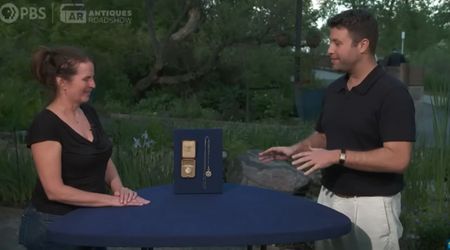Young 'Antiques Roadshow' guest's response is too pure after expert revealed the value of his 1915 pot

On the "Antiques Roadshow," both the artifacts and the guests come in all shapes and sizes. The PBS show has featured some of the oldest and the youngest collectors who brought their prized possessions to show off to the world. One such young guest even got a surprising valuation for an item that he found on his way home from school. Since the silver teapot made his wish come true, he gave it a special name.

A Genie's Lamp
The young boy shared that he believed the item was a “sterling silver teapot,” but he called it a “genie’s lamp” because it had already granted one of his wishes. He explained that he found the pot one day on his way back from school and he got it for free. "What appealed to me about this item is that it had a G on it, which is the first letter of my name, and it looked interesting, like it had history," he explained.

Coming to the special name of the pot, the boy said, “When I was five, I wished to be on TV,” and the antique item made that wish come true. Taking over, the expert of the show explained that it's what they call a demitasse pot, which would be used for coffee rather than tea. "And this was probably part of a set. And the G on there is probably a family name of whoever this belonged to at one point," she noted.
The appraiser confirmed that the pot was made of sterling silver, and the boy was right to spot the 'sterling' label at the bottom of the pot. "If it's 92.5% silver, then it qualifies to be sterling, and it will be marked 'sterling'," she explained.

She further explained that the markings on the plane were for the Wilcox & Wagoner company, which made silver objects in New York City in the 1900s. She explained that after the company went out of business, another company continued to use their mark until 1929; thus, his pot could be dated between 1900 and 1929.
The expert showed that there was a filter-like structure inside the pot, which indicated that it was used to keep the coffee grounds from going into the cup. Furthermore, she noted that the handle of the pot had ivory pieces embedded into the metal. "These are called heat stops. Metal conducts heat, so if you have a hot liquid, it could burn your hand," she explained. She advised the guest that if he ever decided to sell the pot, he should take out the ivory pieces before doing so.

After noting the ivory details of the pot, the appraiser estimated that the item would sell anywhere between $250 to $350 at an auction, which wasn't too bad for something the guest got for free. "Wow! Wow, for something I found on the side of the road, that's amazing!" the young boy exclaimed.
"I hope you find some more stuff on the side of the road," the expert said in response.






















